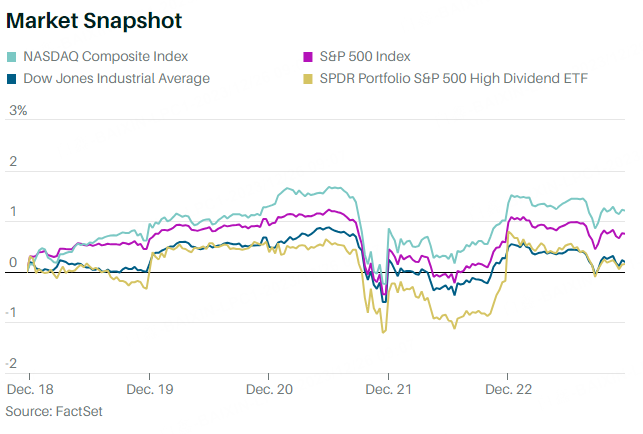Stocks keep soaring, but it isn't too late to get into the market. Just look at the cash sitting on the sidelines.
It's always hard to chase the market, particularly one as strong as this one is. The S&P 500 index gained 0.75% this past week, pushing its winning streak to eight weeks, while the Dow Jones Industrial Average rose 0.2% and the Nasdaq Composite advanced 1.2%.
If it wasn't one thing responsible for the gains, it was another, and even a midweek selloff that saw the S&P 500 drop 1.5% on Wednesday couldn't keep the index down. By Friday, investors got the news they were waiting for: The personal-consumption index gained 2.6% year over year in November, below estimates and lower than the prior reading of 2.9%, reinforcing the notion that the Federal Reserve will probably cut interest rates next year.
The S&P 500 is now up 23% in 2023, and many investors are probably asking if they have missed the rally. Of course they have. Total assets held in money-market funds, at about $6.1 trillion, is near a record, according to the St. Louis Fed. That's about 29% higher than its level just before Covid, as people rushed into cash for the attractive rates.
And even the pros are holding more cash than is typical. The average portfolio manager in a Bank of America survey covering trillions of dollars of assets under management holds about 4.5% in cash, down from a multidecade peak of just over 6% hit last year but still more than the lows of just over 3%. Fund managers still have plenty of cash to put to work.
Nor is equity exposure all that high. The net percentage of respondents in BofA's survey who say they are overweight equities is at about 15%, up in the past few months but below the long-term average -- and well below historical peaks of just over 60%.
History suggests that there is still a lot of buying yet to be done, buying that could support the market in the months ahead. Usually, as the Fed starts cutting rates and the economy is still growing, managers add equity exposure, as seen in 2003 and 2019. And as the Fed cuts rates, short-term Treasury yields and cash savings rates will drop, making them less attractive.
"There's a ton of room for cash to come into the market," says the Bycoff Group's Doug Bycoff.
Of course, simply putting cash to work on its own isn't enough to send stocks higher. Thankfully, there's no reason to think fundamentals shouldn't cooperate. Economic growth is moderating, but inflation is slowing and interest rates are falling. Together, that should keep the S&P 500's aggregate earnings growing at a double-digit pace in 2024 as sales grow modestly, cost inflation subsides, profit margins increase, and companies keep buying back stock and paying dividends.
That sounds like a market we'd want to have our money in.

Comments